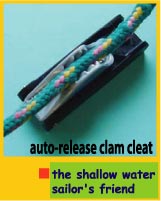
 Custom Search
|
| boat plans |
| canoe/kayak |
| electrical |
| epoxy/supplies |
| fasteners |
| gear |
| gift certificates |
| hardware |
| hatches/deckplates |
| media |
| paint/varnish |
| rope/line |
| rowing/sculling |
| sailmaking |
| sails |
| tools |
| join |
| home |
| indexes |
| classifieds |
| calendar |
| archives |
| about |
| links |
| Join Duckworks Get free newsletter CLICK HERE |
|
|
| Solar Powered Battery Savers |
by Charles Rablin - Townsville, Queensland - Australia |
There have been a lot of solar panels for sale this year at very reasonable prices. The ones I am referring to are the low wattage type used for preventing a battery going flat during storage. The place I have my boat stored is a fair distance from the house and every time the trolling motor batteries need charging, I have to run an extension lead off the 240volt mains. By the time my 8 stage charger has run through its cycle I am out of daylight but don't like to run the charger at night in case of storms, so I have purchased a small solar panel trickle charger to stop the batteries going flat during storage.
The charger I bought has panels that are no bigger than a laptop computer and it has a green light to show when the batteries are charging. When the charging stops because of darkness, it has a device to stop battery power flowing back to the panels. It is 12 volt, 4 watt, 220mA and the instructions say that if my batteries are greater than 35Amp/hr capacity it is not likely to produce enough power to overcharge them. My batteries are an Australian make called Century. They are 6volt, deep cycle, flooded, 105Amp/hr, Type 12A. Lion Batteries also produce a similar one, type N12D. I use these batteries in a pair, one on each side of the centreboard case. It is generally not recommended to use a flooded type of battery in a small sailing boat in case of capsize, however, the boat I am using is a fairly stable fibreglass, multipurpose, 15ft lobster boat from Gig Harbor Boat Works in Gig Harbor USA. It's not over sheeted by any means and I rarely sail in gusty conditions. Also, the batteries are inexpensive and light weight. By dividing the 12 volts into two 6volt units it gives two 15kg batteries that I can lift easily if necessary. For added safety they are securely stowed in ventilated battery boxes.
If I had a choice to upgrade this system I would probably have a 24volt motor with two 12volt batteries in series, as there are more different types of 12 volt batteries out there. But the two 6volt batteries and 12 volt motor are quite adequate for my needs, of getting in and out of tight spots.
When talking about batteries wired in series it is always a good idea to revise what it means. Firstly, two 6volts batteries wired in series give 12volts. In some cases the series type connection is thought to be more reliable than parallel connection (that's if there is a malfunction that causes a loss of performance of one cell) but apart from that the debate between series and parallel gets fairly complex. To wire batteries in series it is best to have batteries of exactly the same type. The first part of the connection is easy; just connect the positive terminal of one battery to the negative terminal of the other, so the batteries are joined in one place only. Next comes the important bit; once the first connection is made the two remaining terminals are "live" and wires connected to them are "live" If they touch there will be a spark. These wires go straight to your switch and fuses and from there to the trolling motor. If the trolling motor turns backwards the connecting wires are "back to front" so switch over the polarity of the wires going to the motor. Note that this is a different system to a car wiring system that has a negative terminal going to "earth" (the body of the car). It is the metal in the body of the car that forms part of the electrical circuit. A boat made of fibreglass (a non conductor) needs a two wire system. The solar battery saver has been a good buy for me and although it looks like a toy it seems to work quite well. Once charged by my multi stage charger on the mains supply, the batteries are staying charged thanks to a good hit of tropical sunshine. If the solar battery saver is used for a couple of days just after the trolling motor has been run, the multistage charger still takes about the same amount of time to go through its cycle, so clearly the solar battery saver hasn't charged up the batteries very much. What it does do, is slow the rate of discharge of my batteries in storage so they are available to me for longer. Only on the very basic system I am using, (of having batteries that are not charged by a motor and not within easy reach of a mains supply) do I get some benefits from the solar battery saver, as it saves me a bit of extra work in the preparation stage when I am busy setting up the boat to go out. |
To comment on Duckworks articles, please visit one of the following:
|
 |






